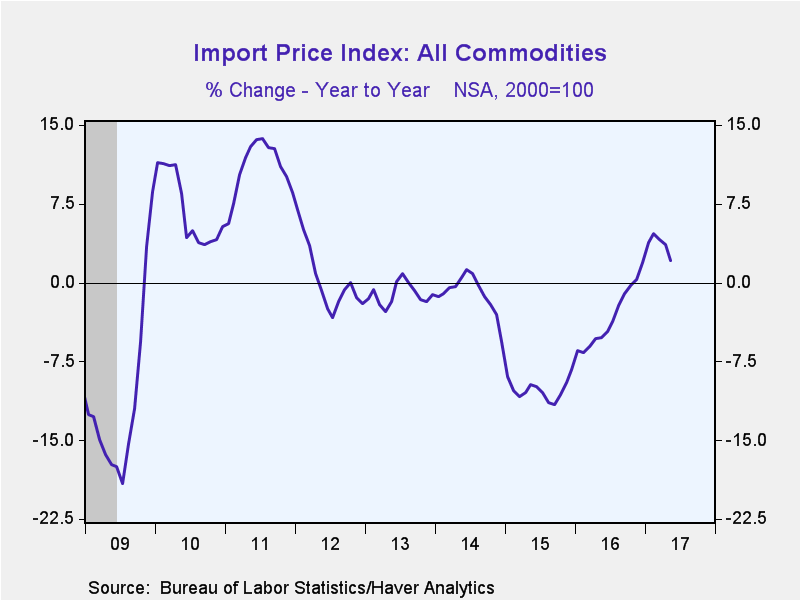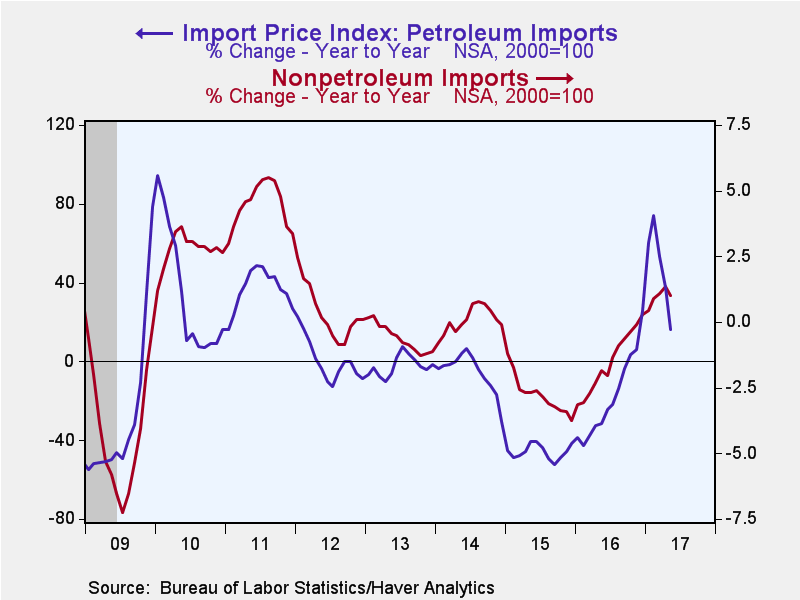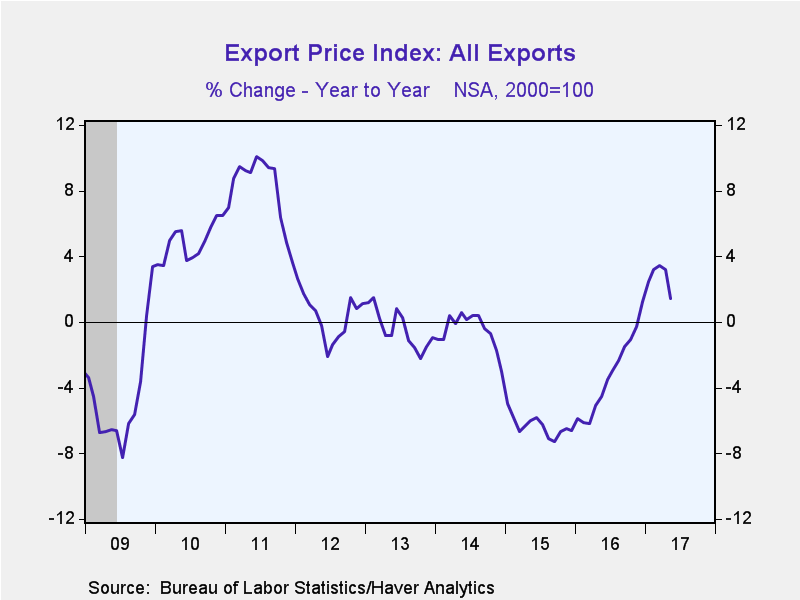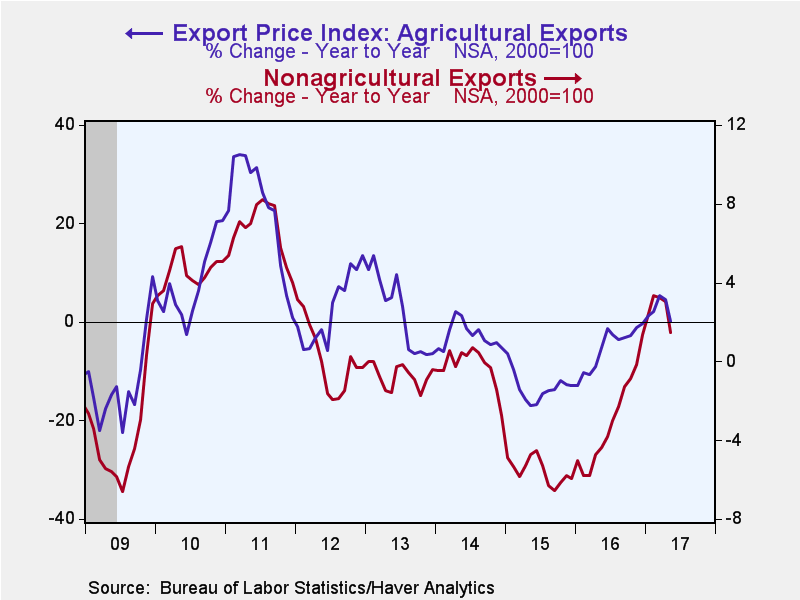 Global| Jun 15 2017
Global| Jun 15 2017U.S. Import Prices Slow as Petroleum Falls, Other Prices Flat
Summary
Import prices fell 0.3% in May (2.1% y/y) following April's 0.2% increase, which was revised from 0.5%. The Action Economics Forecast Survey anticipated no change. These figures are not seasonally adjusted, and they can potentially be [...]
Import prices fell 0.3% in May (2.1% y/y) following April's 0.2% increase, which was revised from 0.5%. The Action Economics Forecast Survey anticipated no change. These figures are not seasonally adjusted, and they can potentially be revised in each of the following 3 months.
Petroleum import prices declined 3.9% (16.2% y/y) in May following a 0.4% decline (revised from a 1.6% increase reported last month). Nonpetroleum import prices were unchanged after April's 0.3% increase, revised from 0.4%; their y/y increase was +1.0%. Among end-use categories, industrial supplies & materials prices excluding petroleum also decreased, down 0.5% (+5.8% y/y), breaking a strong six-month advance. Categories with increases included foods, feeds and beverages, which rose 1.2% (4.1% y/y) and motor vehicle & parts, up by 0.1% (0.1% y/y). Capital goods prices were flat overall (-0.4% y/y) and excluding computers, they eased 0.1% (-0.5% y/y). Consumer goods prices excluding autos were also unchanged in the month, and they were down 0.2% y/y.
Export prices fell 0.7% (+1.4% y/y) in May; their April 0.2% increase was unrevised. The May decline contrasted with the Action Economics Survey expectation of a 0.1% rise. Both agricultural commodity prices and nonagricultural prices were weak in May. Agricultural commodities fell 1.6%, making the y/y rise a mere 0.1%; April's monthly move was +0.1%. Nonagricultural exports were down 0.6% after April's 0.3% rise; their y/y move was 1.5%.
Among the end-use categories, overall foods, feeds & beverage export prices dropped 2.0% (-0.1% y/y). Industrial supplies & materials fell 1.8% (+4.8% y/y), reflecting the downturn in petroleum prices by 6.6% (but up 13.1% y/y). Nonagricultural supplies & materials prices excluding fuels & building materials declined 0.8% (+0.9% y/y), their second consecutive decline after two positive months. Other export categories were little changed in May: motor vehicles and parts prices were flat (+0.2% y/y), capital goods prices rose just 0.1% (0.6% y/y) and nonauto consumer goods also edged up 0.1% (-1.9% y/y).
The import and export price series can be found in Haver's USECON database. Detailed figures are available in the USINT database. The expectations figure from the Action Economics Forecast Survey is in the AS1REPNA database.
| Import/Export Prices (NSA, %) | May | Apr | Mar | May Y/Y | 2016 | 2015 | 2014 |
|---|---|---|---|---|---|---|---|
| Imports - All Commodities | -0.3 | 0.2 | -0.2 | 2.1 | -3.3 | -10.2 | -1.1 |
| Petroleum | -3.9 | -0.4 | -2.6 | 16.2 | -19.7 | -46.0 | -5.6 |
| Nonpetroleum | 0.0 | 0.3 | 0.1 | 1.0 | -1.5 | -2.8 | 0.1 |
| Exports - All Commodities | -0.7 | 0.2 | 0.2 | 1.4 | -3.2 | -6.3 | -0.5 |
| Agricultural | -1.6 | 0.1 | 1.1 | 0.1 | -5.4 | -13.3 | -2.7 |
| Nonagricultural | -0.6 | 0.3 | 0.1 | 1.5 | -3.0 | -5.5 | -0.3 |
Carol Stone, CBE
AuthorMore in Author Profile »Carol Stone, CBE came to Haver Analytics in 2003 following more than 35 years as a financial market economist at major Wall Street financial institutions, most especially Merrill Lynch and Nomura Securities. She has broad experience in analysis and forecasting of flow-of-funds accounts, the federal budget and Federal Reserve operations. At Nomura Securites, among other duties, she developed various indicator forecasting tools and edited a daily global publication produced in London and New York for readers in Tokyo. At Haver Analytics, Carol is a member of the Research Department, aiding database managers with research and documentation efforts, as well as posting commentary on select economic reports. In addition, she conducts Ways-of-the-World, a blog on economic issues for an Episcopal-Church-affiliated website, The Geranium Farm. During her career, Carol served as an officer of the Money Marketeers and the Downtown Economists Club. She has a PhD from NYU's Stern School of Business. She lives in Brooklyn, New York, and has a weekend home on Long Island.









